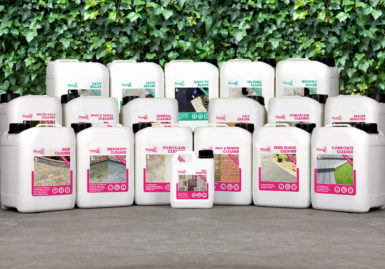Natural Stone Care: Cleaning, Sealing & Maintenance for Sandstone & Limestone Pavers

Keep your natural stone pavers looking new with the right cleaning, sealing, and maintenance routine. This guide covers Indian sandstone pavers, limestone pavers, pool coping stone, and driveway pavers—including acid-free cleaners, how to seal sandstone or limestone, and solutions for rust, algae, efflorescence, and winter salt. We reference Pavetuf products (our polymeric sand alternative jointing system’s companion cleaners & sealers) designed for natural stone hardscapes.
Why Natural Stone Maintenance Matters
- Enhances color and character while preventing discoloration.
- Protects against moisture, de-icing salts, and pool chemicals.
- Improves traction on pool deck stone pavers and patio pavers.
- Extends lifespan on natural stone driveway pavers subjected to vehicles.
Quick Do’s & Don’ts (Sandstone & Limestone)
Do
- Use acid-free, stone-safe cleaners; rinse thoroughly.
- Test in a small, inconspicuous area first.
- Reseal high-traffic zones (driveways, pool decks) as needed.
- Keep joints intact; regrout with Pavetuf jointing compound if needed.
Don't
- Use muriatic acid or harsh solvents (can etch stone, expose iron, and trigger rusting).
- Pressure-wash too close (can damage surface or joints).
- Let cleaners dry on the stone in sun/wind—keep damp until rinsed.
- Use wire brushes or abrasive pads (they can scratch sandstone and limestone surfaces permanently).
Step-by-Step: Routine Cleaning (All Outdoor Stone Pavers)
- Dry prep: Blow or sweep debris.
- Pre-wet: Mist surface so the stone doesn’t “flash-dry” cleaner.
- Clean: Apply Pavetuf General Cleaner for light soil; agitate with soft brush.
- Dwell: 5–10 minutes (don’t allow to dry).
- Rinse: Low-to-moderate pressure; push dirty water off the surface.
- Inspect joints: Top up with Pavetuf jointing compound if gaps appear.
Deep Cleaning & Stain Removal
- Grease/Oil (grills, driveways):
Use Pavetuf Deep Cleaner; agitate and rinse. For stubborn vehicle drips on stone driveway pavers, repeat after 24–48 hrs. - Green Algae/Moss/Shade Build-Up:
Treat with Pavetuf Green Off Cleaner; great for non-slip stone pavers on pool decks and shaded stone walkway pavers. - Rust/Orange Staining (sprinklers, furniture):
Apply Pavetuf Rust Remover (turns purple on contact with iron). Keep surface wet and never let product dry on stone. Rinse thoroughly. Note: Acid exposes iron in sandstone/limestone and can worsen rust; use Rust Remover to neutralize that reaction. - Salt/De-icer Residue (cold climates):
Use Pavetuf Salt Eraser; ideal for stone pavers for cold climates.
Sealing: Invisible vs Satin (When & Why)
- Invisible Penetrating Sealer:
Preserves a natural, matte look on Indian sandstone and Indian limestone. Helps resist water, oils, and stains while allowing vapor transmission.
Best for: patios, walkways, modern large format stone pavers where a natural finish is desired.
- Satin Sealer (enhancing sheen):
Adds a subtle glow and boosts color on patios and entertaining areas.
Best for: backyard stone patio zones needing extra pop.
How Often to Seal?
Every 2–3 years on patios; 1–2 years on high-traffic driveway pavers and pool deck stone pavers (UV, water, and traffic accelerate wear).
Pool Decks & Pool Coping Stone (Non-Slip, Chlorine, Salt)
- Choose non-slip pool coping stone textures (riven or tumbled edges) and keep sealed for easier cleanup.
- Rinse after heavy pool use (chlorine/salt).
- Promptly clean sunscreen and beverage spills; they can leave films that reduce traction.
Winter Care & Freeze–Thaw (Limestone & Sandstone)
- Avoid harsh de-icers; use calcium-magnesium acetate or sand for traction.
- Keep joints sound to reduce water ingress and heaving.
- Seal against water and salt uptake; reapply sooner in snow-belt regions.
Driveways: Heavy Duty Considerations
- Best pavers for driveway: dense limestone driveway pavers and calibrated Indian sandstone driveway options like De Terra (2"+ or ASTM-rated thickness) with correct base prep.
- Blot automotive fluids quickly; treat with Deep Cleaner; reseal sooner due to traffic.
Troubleshooting at a Glance
- White haze/efflorescence: Usually salts migrating; gentle detergent, multiple rinses; allow weathering; seal once stable.
- Slippery surface: Remove biofilm with Green Off, avoid film-forming products; keep joints maintained.
- Dull color: Deep clean, then Satin Sealer to restore richness.
- Open joints: Regrouting natural stone pavers with Pavetuf jointing compound.
Frequently Asked Questions
How thick should patio pavers be?
For natural stone patio pavers, 1–1¼" is common for pedestrian patios on properly prepared bases; heavy duty pavers for driveways are typically thicker—ask your installer.
How long do stone pavers last?
Decades with correct base prep, sealing, and routine maintenance.
Can I use acid to remove grout haze on sandstone or limestone?
No—acids can etch stone and expose iron. Use an acid-free, stone-safe cleaner and Pavetuf Rust Remover if orange staining appears.
What’s the best stone for patios?
Indian sandstone pavers and limestone pavers are both excellent; choose texture/finish (riven vs smooth) and color to suit design and slip-resistance needs.